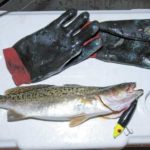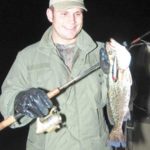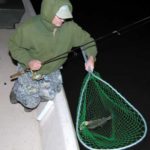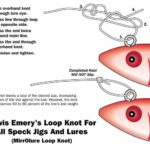
Masonboro is a prime spot to find monster spotted seatrout during the dark days of winter.
It’s easy to tell when the speckled trout are biting at Masonboro Inlet. All you have to do is take a look at the boats lined up along the jetties, their anchor ropes pointing out the average direction of friction against the boat hull battled to a stalemate by the wind and the tide.
Finding a parking spot between the anchored boats can be mighty tough during the peak bite, which can occur in December or January. Even those arriving at first light will find the competition is fierce for the best fishing spots. But come nighttime, most of the anglers head for the comforts of home and the warmth of hearth.
Those in the know pass the boats heading in. Switching on their navigation lights they head for the spots the daytime anglers have just vacated.
At age 29, Lewis Emery has been fishing the Wrightsville and Carolina Beach areas his entire live. It’s only in the past three years he’s hung out his shingle as a fishing guide. His mode of transportation, a 19-foot Carolina Skiff, is about as simple as it gets. But he said it doesn’t take a big boat to catch a boatload of big specks.
“In December the Wrightsville Beach jetties are great for specks,” he said. “I fish about a hundred different trout lures, but certain ones are better for night fishing at the jetties.”
Emery said speckled trout are natural night feeders, and the biggest ones eat after sunset.
“The trick for catching monster trout is to work the lure slowly,” he said. “The water’s colder, so you have to slow things down. Besides, those really big trout are the laziest. They don’t want to chase their midnight snacks any farther or faster than they have to. Move (a lure) fast and the little guys are going to get to it first.”
Emery uses MirrOlures in 52m and TT models. He said the 52m works shallower and the T’s get hung up more often. Which one he uses depends upon how the tide, wind and water depth keep him off the rocks.
“I like the silver-with-blue-back, black Night Stalker and Purple Demon T’s,” he said. “Rainbow Trout is another good color. Whichever one I use, I put Lunker Sauce paste on it. I like to use the mullet flavor when I’m fishing for trout at the jetties with MirrOlures.”
In addition to hard lures, Emery also uses soft plastics with jig heads, with many styles of trailers. He switches the sizes of the jig heads as well.
“I use a 1/8- to ¼-ounce jig head,” he said. “Sometimes I even tie them in tandem. I use the D.O.A. paddle tails and the Cal Series jerk-bait styles. Good colors are Greenie, Electric Chicken, Root Beer or Glow. With the soft plastics I prefer using the shrimp flavor Lunker Sauce.”
Emery also uses live baits on the same small jig heads, buying the jigs at Island Tackle at Carolina Beach or Mot’s Seafood at Wrightsville Beach.
“I also try to catch (live bait) in Bradley Creek,” he said. “They can be expensive if you have to buy them. You can go through a lot of shrimp if the pinfish are still around.”
The darker moon phases are the best fishing for Emery’s methods. He said he doesn’t like fishing the full moon.
“I like fishing the dark of the moon,” he said. “If the moon is rising, I want to fish an hour or two before or after moonrise, not when it’s straight overhead.
“I also pick nights (to fish) a day or two before and a day or two after a weather front. The big specks bite best on a pressure drop or during a steady barometer. The little trout bite when the pressure is rising. They’re like teenagers because they eat anytime.”
If the wind is blowing too hard to fish the jetties, Emery heads for nearby creeks. He uses topwater lures in the creeks where the water is calmer.
“Super Spook Jr. and Rapala Skitterwalks work well for night fishing,” he said. “The Rapalas make more noise, but the Spooks are easier for inexperienced clients to work properly.”
Emery ensures hookups by switching out the treble hooks on his topwater lures. He uses a Sure Set Treble hook, model No. 5537.
He uses spinning rigs spooled with 10-pound test braid and ties on a 12- to 15-pound fluorocarbon leader with lures and a 20-pound fluorocarbon leader when using shrimp. He said the leader is long enough to grab when swinging fish weighing a pound or two into the boat.
“A rubber net can save fishing time, but a MirrOlure still gets hung in the mesh,” he said. “You’re going to catch lots of small trout, so it’s easier if your rig lets them land them without the net.”
Jeremiah Hieronymus is another young guide who has fished the area his entire life. Now age 27, he has been guiding clients for two years and, similar to Emery, has developed a fondness for night fishing. He fishes from a 22-foot Shearwater Bay Boat.
“I fish for trout on calm nights,” he said. “I fish the slough that runs along the north jetty when the wind is out of the north to stay out of the wind. The bar is very shallow so you have to be careful. Another good place on a north wind is the beach side of the south jetty. When the wind is from the south, I fish the north side of the south jetty.”
Hieronymus uses the same styles of MirrOlures as Emery. He also prefers dark colors at night, but he likes fishing during bright moon phases.
“I like fishing the full moon because of the visibility,” he said. “I don’t think trout are affected by the moon phase that much. With a full moon, it’s like fishing in the daytime. If you fish the waters you’re familiar with in the daylight, you can run them the same way at night.”
Hieronymus uses Sea Striker grubs in dark colors. He likes fishing with black or purple fire tail grubs or dark green without the fire tail.
“I fish the grub by flipping it out and letting it fall halfway down the water column,” he said. “At the jetty, you’re fishing in 7 to 12 feet and trout stay low but not right on the bottom. I fish just slow enough to make sure the tail twists. Every now and then, I give it a little jigging action.”
Hieronymus uses a 7-foot Pfleuger spinning rod and Pfleuger Medalist reel with either 10- to 15-pound braided line or 8 to 10-pound monofilament line. He uses a 20-pound mono leader.
“You need the line profile down as much as possible,” he said. “The braid can make the difference because you can detect strikes you would miss using mono.”
Hieronymus uses a heavy anchor and anchors so the wind is blowing the boat toward the rocks. He said specks bite best on the windward side, but he doesn’t fish unless it’s calm.
“You have to the fish safe conditions,” he said. “But you have to be aware you can be tying a knot and not paying attention and if the anchor slips, you could be right on the rocks before you know it.”
Hieronymus uses a clip-on fluorescent light designed for an outdoor grill for night fishing. It has a swivel mount so it can cast a weak light in any direction when hooked up to his boat’s console. It gives off just enough illumination for landing a speckled trout.
The tide phase dictates whether the jetties are worth fishing. He said the larger number of big fish come from the jetties. But the best time to fish them is the last of the falling tide while the best time to fish the marshes is the final quarter of the rising tide.
“You’re going to have to learn where they bite on the different tides,” he said. “Moving around from the jetties to Pages and Futch Creek, then give the back side of Figure Eight Island a try. Sooner or later, you’re going to run into them. Once you do, you’ll be hooked on night fishing.”









Be the first to comment